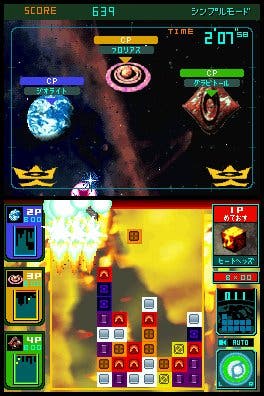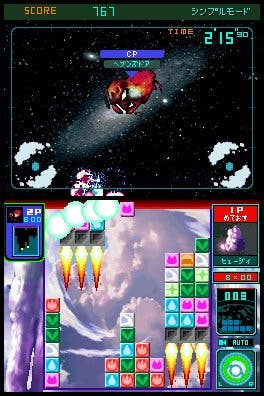Meteos
It rocks. And it is rocks, too.
Q Entertainment's having a pretty good month. PSP puzzler Lumines has been on sale in America for less than a week, but already there are signs that the yanks are head over heels in love with it. More so than we expected, in fact. Lumines, which might be described as Rez creator Tetsuya Mizuguchi's baby, literally turns the falling blocks puzzle genre on its side, tasking you with arranging blocks in a play area that's about twice as wide as it is tall. Squaring same-coloured blocks together sees a horizontal line that moves across the screen again and again wipe them away on its next pass - all the while the action is not so much heralded as enforced by a varied and varying soundtrack comprised of popular Japanese dance acts. There's no question that it's great. We just wonder, big-numbered US review scores freshly in mind, what the same critics will make of Q's other puzzle game out this month in Japan, Meteos, which we're finding far more enjoyable.
Meteos is the creation of Masahiro Sakurai, another developer at Q with unquestioned pedigree. The former HAL Laboratories man was the creator of the Kirby and Smash Bros. series, which puts Meteos in good stead to be quirky but brilliantly fashioned, and that it certainly is. And thanks, perhaps, to Mizuguchi's influence on the project, as well as being the finest reworking of the falling blocks puzzle game we've seen so far in 2005 it also manages a fine blend of eye-popping pyrotechnics and clever, reactive accompaniment.
It's simple enough but fiddly to explain, because beneath the surface pitch there's so much to take into consideration - which is true of just about all the greats in the genre. On a basic level, the idea is to clear blocks (meteors, for the sake of the story) that fall down a rectangular play area - standing tall in more traditional style, this time, though only covering the lower DS screen. You do this by using the stylus to drag individual blocks up and down the columns they've fallen into. When this produces a line of three or more blocks either horizontally or vertically, they, well, they blast off. Instead of just disappearing, rockets pop out of the block-line and propel it up the screen. Depending on the number of blocks you're trying to boost and the level of gravity your current "planet" has to pull them back with, they'll either disappear off the top, never to return, or make it part way up the screen before starting to tumble back.

Brilliantly, you can not only boost them further by repositioning the blocks left on the ground to form more lines when they tumble and slot into place alongside them - providing an even greater boost and a sort of combo for more points - but if you're quick you can also reposition blocks in the formation that's floating back down the screen. As it's falling. Or you can push blocks up from below so they group with the floating blocks to make more lines there. And so on. It can be a little fiddly to slide the fairly small blocks accurately up or down a block pile in mid-air, particularly when they're tumbling at speed as they do from time to time, but the franticness just adds to the fun. And continually juggling the multiple worries of differing degrees of gravity, your block pile's momentum, ever-towering columns, the varying pace of falling blocks and all the rest quickly amounts to an engrossing task. Fans of EG continuity will be interested to hear that Meteos has usurped Zoo Keeper already.
You could argue that there isn't much more to it. But there is; it's just that most of what else there is makes it more fun without obscuring the point. There are loads of different planet types, which means loads of different coloured and patterned blocks to deal with - and even this simple step adds a huge amount of variety to the equation. As do the varying conditions, which make some planets really hard to budge any blocks from and some worryingly easy. In other words, you have to get a handle on the different factors on a per-map basis to work out how to truly exploit them to gain the maximum points total. If things slow down too much, you can hold a shoulder button to speed up the flow as and when you want it.
Then there's the musical influence. Music doesn't seem to play a specific role in gameplay terms, but the way it's woven into the fabric of Meteos is typical Mizuguchi and arguably just as essential as it is in his other efforts. The music itself seems to rise and fall with the boosting and sinking blocks, shifting tone and tempo as you play to reflect your moves. There's an underlying beat, the blocks sound out as they fall, there are little trumpety fanfares of increasing excitement as you boost more and more blocks away, and there are separate sounds of increased rapture for particularly natty combo moves - as if the game can barely believe how good you are and is yelping along as fast as it can. By the end of a round as your screen fills up and your stylus weaves boosting blocks out of the mayhem, the sound is like joyous delirium, sirens warning you of impending doom clashing with horns and swooping noises and all the rest, and you wouldn't turn it off unless you really had to. Meteos sounds better the better you play it. Just ask the folks on Eurostar last Thursday who had to put up with me getting used to the game for two and a half hours as I went on my hols. DA-da-DA-da-DA-DA-DAAAH!

Visually it's no slouch either, matching the auro-technics like for like with some wonderful sights. The different varieties of meteor blocks are distinct - and you come to know what they mean in terms of gravity and the like soon, too - and boost, fall, explode and generally behave in flamboyant fashion. The top screen, meanwhile, is given over to the threat you're using your meteors to neutralise. The story, such that it is, concerns the plight of little intergalactic stick-men who want to protect themselves from rock-chucking interstellar adversaries, and they do this by propelling the falling blocks back up at them, obviously. Which means you get to see something being pummelled by your boosted blocks whenever you send them up to the top.
At the moment it's hard to find fault with it all. We haven't tested out the multiplayer options yet for one reason or another (the one reason being that I was away for several days, the other being that we have a stack of games as big as a house to tackle this week), but the single-player options have been quite sufficient to drain two batteries' worth of DS juice in just a few days, with more surely to come. As well as a basic open-ended mode (which can be played against the clock, too, with varied difficulty options and so on), there's also a challenge-based mode that involves tackling a series of different planets one by one in branching arrangements before taking down Meteos' equivalent of the Eye of Sauron at the end of it all, and there's also a place to go to tackle planets individually, and there appear to be a good deal of unlockables.
Sadly though details of the latter elude us so far thanks to the volume of Japanese text. Meteos is perfectly playable - and thunderously enjoyable - in its native form, but there are questions that our kanji-ignorant brains have no answer to, and the worth of the unlockables is one such query. Nintendo of America has just confirmed that it plans to publish Meteos in the US this June 27th (an earlier version of this preview pleaded for somebody to do so; my wish is now apparently Nintendo's command, which should be handy), and hopefully we'll also see a European release thereafter, giving us another chance to tackle it. If you're prepared to take the jump now though, you'll be unlikely to regret it. Along with Zoo Keeper and other like-minded titles, Meteos cements the DS's reputation as the puzzle handheld of choice, whatever the Lumines eulogies suggest to the contrary, and it's loved on all sides - as much by the developer as the player. It's imaginative and indulgent through and through - from the needless intro videos for each section to the parade of designers' signatures for end credits - and that's why, well, it rocks.

